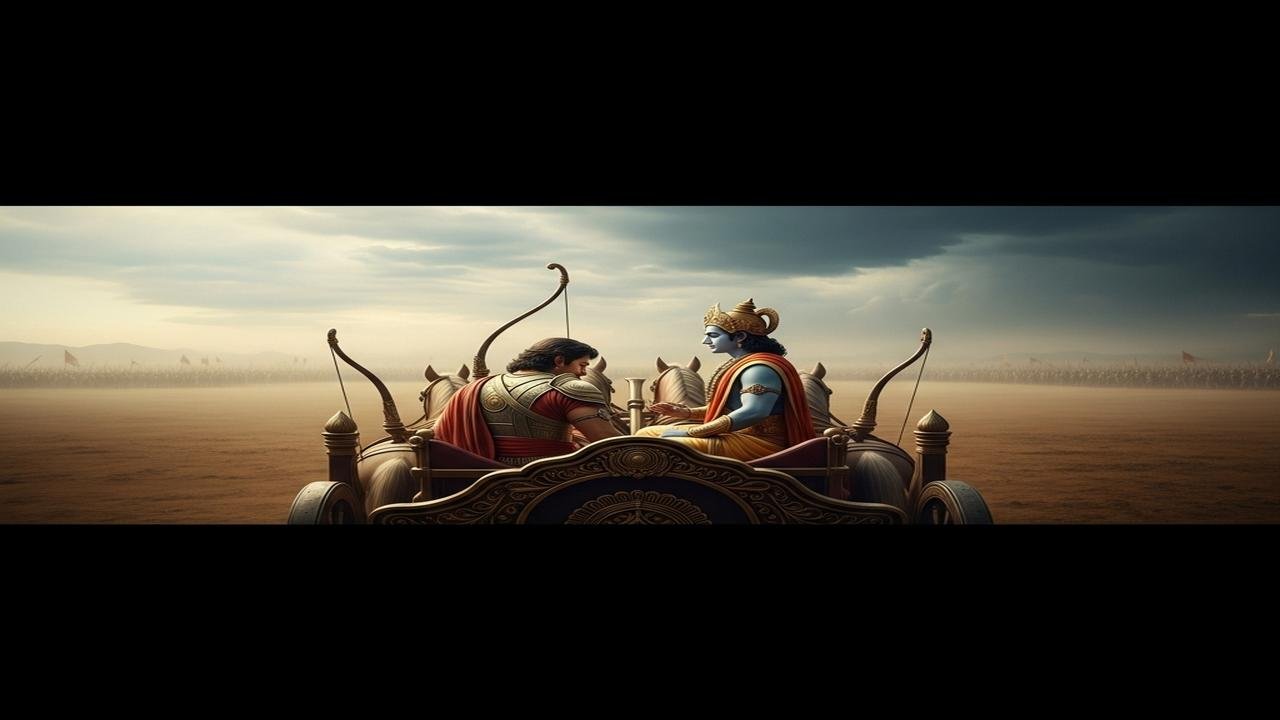Bhagavad Gita Chapter 1: Arjuna’s Refusal at Kurukshetra

Context on the battlefield
The scene is one of the most widely known set pieces in Indian sacred literature: the plain of Kurukṣetra, the morning before the decisive battle narrated in the Mahābhārata. Into that plain steps a small, human drama that becomes the setting for the Bhagavad Gītā. The Gītā appears as a dialogue embedded in the Bhīṣma Parva of the Mahābhārata and unfolds over eighteen chapters and 700 verses. The emotional crisis that opens the poem is commonly called Arjuna-viṣāda — Arjuna’s despondency — and it is detailed in Chapter 1, where the warrior Arjuna declares that he cannot fight.
The moment: Arjuna lays down his bow
Standing on his chariot, Arjuna looks across at relatives, teachers and friends arrayed on both sides. He sees fathers, sons, cousins, gurus — many of whom will be killed if the war proceeds. Overcome, he experiences nausea, doubt and a moral collapse. He tells Krishna, his charioteer and lord, that the bow slips from his hands and that his mouth is dry; he refuses to engage in combat. The refusal is not a tactical withdrawal but an ethical and emotional crisis that interrupts the martial logic of duty.
What Arjuna’s refusal represents
- Personal grief and compassion: Arjuna’s reaction foregrounds compassion for kin. He imagines the suffering of families that will follow death on the field.
- Moral confusion: He questions the value of victory when it costs the lives of teachers and elders; the classic conflict is between social duty and personal ties.
- Existential breakdown: The scene portrays a human being whose steady identity as a warrior is destabilised by the sight of death and its consequences.
Key terms to hold in mind
- dharma — ethical duty or social-religious obligation; here Arjuna’s role as a warrior raises questions about the obligations of his caste and office.
- ahimsa — nonviolence; while not the central doctrine of the Gītā, concerns about harm to others are clearly present in Arjuna’s protest.
- saṃsāra — the cycle of birth and death; later Gītā teaching addresses this cosmic frame to reorient Arjuna beyond immediate attachments.
Philosophical and pedagogical readings
Scholars and commentators read the refusal in multiple, often complementary ways.
- Ethical dilemma: Many readings treat the episode as a paradigmatic moral conflict — what to do when different obligations pull in opposite directions.
- Psychological realism: Modern commentaries emphasise Arjuna’s affective state — grief, dread, moral injury — and see the Gītā as addressing the psychology of decision-making.
- Spiritual pedagogy: The refusal serves a narrative function: it opens space for Krishna’s teaching. Numerous interpreters see Arjuna’s weakness not as failure but as a necessary precondition for receiving higher instruction.
How classical commentators approached it
Different Vedāntic and Bhakti traditions read the scene through their own lenses.
- Śaṅkara (Advaita) and advaita readings: Tend to interpret Arjuna’s collapse as arising from ignorance (avidyā) about the true self; knowledge of the undying ātman is the cure.
- Rāmānuja (Viśiṣṭādvaita) and Vaiṣṇava readings: Emphasise surrender to Krishna and the role of devotion as the corrective to despondency; Arjuna becomes the devotee who learns to act in union with the Lord’s will.
- Other traditions: Madhva and later commentators read the exchange in light of their doctrinal commitments, but most agree that the crisis is the narrative hinge that justifies the Gītā’s teachings.
Modern and comparative perspectives
Contemporary scholars, psychologists and ethicists find in Arjuna’s refusal material for debates about moral injury, decision paralysis, and leadership under stress. In political and pedagogical contexts, the episode is often used to teach ethical reasoning, the limits of duty without reflection, and the importance of moral imagination — the capacity to see the human costs of one’s actions.
Cultural and ritual afterlives
The opening scene of the Gītā is widely reproduced in devotional, theatrical and pedagogical settings. It appears in dance-drama, in recounting at festivals and in moral instruction in schools and religious discourses. Rather than a single doctrinal point, the story functions as a shared cultural prompt for discussing duty, compassion and the moral complexity of political action.
Why the episode still matters
Arjuna’s refusal is enduring because it articulates something universal: the moment when roles and responsibilities clash with conscience and feeling. It does not offer an immediate solution; instead, it stages a question so deep that it invites teaching, dialogue and reflection. Across traditions, commentators have used it to explore how one acts rightly in a world where harm is sometimes unavoidable, and how inner clarity, knowledge, devotion or wise leadership can reframe the choice.
Ways this scene is used today
- Ethics courses use it as a case study in competing duties.
- Religious teachers use it to introduce the Gītā’s doctrines on action, knowledge and devotion.
- Artists and performers dramatise Arjuna’s breakdown to provoke empathy and public reflection on violence and consequence.
Interpreting Arjuna’s refusal requires patience and humility. The episode resists easy conclusions: it is a human cry that becomes an opening for cosmology and counsel, for doctrine and devotion. Whatever your approach — philosophical, devotional, psychological or literary — the moment asks the reader to attend to what it means to act when the price of action is the pain of those we love.
